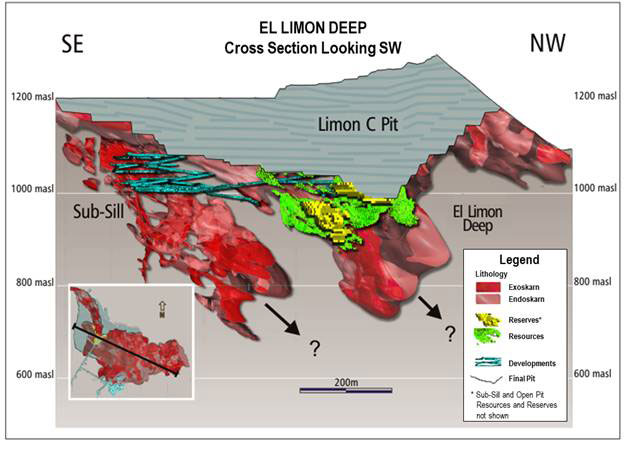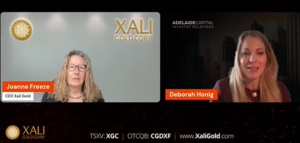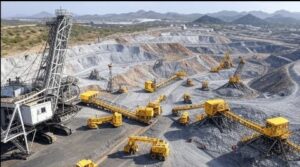TORONTO, Ontario, June 20, 2019 – Torex Gold Resources Inc. (the “Company” or “Torex”) (TSX: TXG) announces a maiden underground mineral reserve estimate and resource estimate for the El Limón Deep zone (“ELD”) at its El Limón Guajes mining complex (“ELG”), located in Southwest Mexico. The estimates were prepared in accordance with National Instrument 43-101 (“NI 43-101”) and CIM Standards (defined below).
ELD Mineral Reserves and Resources
- The probable mineral reserve at ELD contains 86,000 Au ounces in 487,000 tonnes at an average Au grade of 5.50 g/t, with a cut-off grade of 3.70 g/t.
- The mineral reserve is a subset of an indicated mineral resource at ELD that contains 141,000 Au ounces in 797,000 tonnes at an average Au grade of 5.52 g/t, with a 2.5 g/t cut-off grade.
- The conversion rate of indicated mineral resources (at the reserve cut-off grade) to probable mineral reserves is estimated at 72% for Au ounces and 86% for tonnes.
- The mineral resource is the downdip extension of mineralization in the El Limón open pit. It is located approximately 400 meters north-northwest of the Sub-Sill deposit and is open in three directions.
Fred Stanford, President and CEO of Torex, stated:
“This addition of the ELD mineral reserves, while small in comparison to the open pit mineral reserves, provides a nice sweetener to the open pit production. It is also indicative of the potential to add further underground mineral resources. With ELD open in three directions, the Sub-Sill underground deposit still open at depth, and the potential for down dip extensions of Guajes, we are upbeat about the potential to further expand underground reserves and resources through multiple sources.
“The mineral reserves for the ELD deposit have been estimated using conventional mining techniques and costs. The intention is to mine the deposit with the Muckahi mining system. If as expected, the costs associated with Muckahi mining are lower than conventional mining costs, we may be able to lower the cut-off grade and increase the size of the mineral reserve. Excavation of the 30-degree down ramp to access the lower parts of the ELD deposit is underway, with 4 rounds taken. In the upper portions of the deposit, the excavations are nearly completed for the initial long hole stopes that will be mined utilizing the production aspects of the Muckahi system. To date the Muckahi system has performed as expected, we are all eager to progress through the next stages of the testing program, and if proven, then move forward with the strategic options it has the potential to unlock.”
Mineral Reserve Statement, ELD Underground, April 2019
Reserve Category | Tonnes | Au Grade | Ag Grade | Contained Au | Contained Ag |
|---|---|---|---|---|---|
Proven | – | – | – | – | – |
Probable | 487 | 5.50 | 6.44 | 86 | 101 |
Proven & Probable | 487 | 5.50 | 6.44 | 86 | 101 |
Notes to accompany ELD Zone Underground Mineral Reserve Table:
- ELD Underground mineral reserves are based on an indicated mineral resource; mineral reserves have an effective date of April 15, 2019.
- The mineral reserves are based on mechanized cut and fill mining with an estimated ore cut-off grade of 3.7 g/t Au and an incremental cut-off grade of 0.9 g/t Au.
- Mineral reserves are estimated using a metal price of US$1,200/oz Au.
- The mineral reserves process plant recoveries are 87% for gold and incorporate estimates for mining dilution and mining losses.
- Rounding may result in apparent summation differences between tonnes, grade, and contained metal content.
- Mineral Reserves were developed in accordance with CIM Standards.
- The qualified person for the mineral reserve estimate is Clifford Lafleur, Professional Engineer of Ontario, Canada and a Torex employee.
The underground ELD mineral reserves are based on a three-dimensional mine design assuming conventional overhand mechanized cut and fill (“cut and fill”) mining method. The mine was designed and scheduled in Deswik® software suite, a commercially-available mine planning software package. The mine plan physicals were estimated by interrogating the three-dimensional mine designs against the resource block model to which factors for dilution and mining losses have been applied. The delineation of reserves for ELD has not impacted reserves from within the El Limón open pit.
ELD will be accessed through the existing underground development and will utilize the existing site infrastructure. This infrastructure includes, but is not limited to, electrical facilities, maintenance facilities, main ventilation exhaust fans and the backfill plant. Depending on material availability and geotechnical requirements, all mining areas at the ELD will be backfilled with either cemented aggregate fill or uncemented rockfill.
The mine plan is expected to deliver 487,000 tonnes and 86,000 ounces to the ELG processing facility at an average grade of 5.50 g/t Au. ELD is expected to supplement existing ELG underground mine production. The crown pillar below the El Limón open pit will be mined and backfilled well in advance of surface operations.
Maximum mining rates in the plan are estimated at 800 tonnes per day. Mining costs are estimated to be US$85.6/tonne plant feed, based on conventional mining methods. Total capital requirements are estimated to be US$13.5 million, of which US$10.5 million is allocated for lateral and vertical development.
Mineral Resource Statement for ELD Underground
Resource Class | Tonnes | Au Grade | Ag Grade | Contained Au | Contained Ag |
|---|---|---|---|---|---|
Measured | – | – | – | – | – |
Indicated | 797 | 5.52 | 6.62 | 141 | 170 |
Measured & Indicated | 797 | 5.52 | 6.62 | 141 | 170 |
Inferred | 1,090 | 5.20 | 6.95 | 182 | 243 |
Notes to accompany ELD Zone Underground Mineral Resource Table:
- The effective date of the estimate is April 15, 2019.
- Mineral resources are reported above a 2.5 g/t Au cut-off grade. The assumed mining method is from underground.
- Mineral resources are reported using long-term metal prices of US$1,380/oz gold and US$21/oz silver.
- Metallurgical recoveries are assumed to be 87% for gold and 32% for silver.
- Mineral resources are reported inclusive mineral reserves; mineral resources that are not mineral reserves do not have demonstrated economic viability.
- The mineral resources are stated below the mineral reserve pit of the El Limon deposit. Declaration of mineral resources amenable for underground extraction removes 170 kt (10 koz Au), 2,360 kt (190 koz Au), and 420 kt (40 koz Au) from the measured, indicated, and inferred open pit resource as reported December 31, 2018, respectively.
- Mineral resources are classified in accordance with the CIM Standards.
- Rounding as required by reporting guidelines may result in apparent summation differences between tonnes, grade, and contained metal content.
- Mineral resources are reported as undiluted; grades are contained grades.
- The estimate was prepared by Dr. Lars Weiershäuser, P.Geo., an employee of the Company, who is a “Qualified Person” under NI 43-101.
ELD Geology
The ELD zone occurs in the northwest portion of El Limón deposit, which is part of the large gold bearing skarn system of ELG, located in the central part of the Guerrero Gold Belt in Southwest Mexico. The ELG deposit is hosted in Mesozoic-age rocks of the Morelos Platform, which have been intruded by Paleocene granodiorite stocks, sills, and dikes. Skarn-hosted gold mineralization is developed along the contacts of the intrusive rocks with carbonate-rich sedimentary host rocks of the Cuautla and Morelos formations. ELD represents the down-dip extension of the gold mineralization targeted in the El Limón open pit and is located directly below the deepest part of the El Limón final pit.
The style of mineralization at ELD is similar to the mineralization in the other mineralized zones within the ELG deposit. It is characterized by a strong association with bismuth and variable amounts of silver and copper. Gold occurs in variably sulfidized, pyrrhotite-rich skarn, while silver and copper mineralization is primarily determined by the degree of sulfidation of the host skarn. Mineralization is associated with retrograde alteration characterized by amphibole, calcite, and quartz, with lessor amounts of chlorite ± epidote. This alteration affects the pyroxene-garnet exoskarn and granodiorite-related endoskarn. Locally, mineralization occurs in narrow lenses of massive sulfide.
Mineralization of the ELD zone is juxtaposed on either side of the Flaca fault, a major structure that strikes north-easterly and transects the El Limón deposit. The fault separates mineralization with a shallow, approximately 30° dip in the southeast of the fault from steeply dipping mineralization northwest of the fault.
Mineralization remains open along strike especially to the southwest and downdip to the northwest. Additional mineral potential is envisaged in the multiple skarn zones identified at depth. Additional step-out drilling is ongoing, and additional results will be incorporated into future resource updates.
For a cross section of ELD refer to Figure 1.
Mineral Resource Estimate Methodology
The mineral resource is informed by drilling (surface and underground) that include assays received up to March 31, 2019. Of the approximately 2,120 holes (281,300m) completed on the ELG project between 2000 and 2019; a total of 209 holes (52,441m) is located in the ELD mineral resource area and was considered for estimation. Assays were composited into 2-metre lengths within lithological grade domains for estimation into 2-metre cubic blocks. Leapfrog Edge, a commercially-available geologic and block modelling software package, was used to produce a three-dimensional block model. Specific gravity was assigned by rock type and gold grade. Block grades were estimated in three estimation passes with increasingly relaxed search parameters using ordinary kriging and hard boundaries for gold, silver, and copper. Treatment of high-grade gold samples include capping and further restriction of grades beyond a narrow search ellipsoid. Silver and copper assays were not capped. Mineral resources consider geologic, mining, and processing constraints. Mineral resources are classified in accordance with the 2014 CIM Definition Standards for Mineral Resources and Mineral Reserves and the 2003 CIM Estimation of Mineral Resources and Mineral Reserves Best Practice Guidelines (collectively, the “CIM Standards”).
The mineral resources for ELD are stated below the mineral reserve pit of the El Limón deposit and overlap the mineral resources amenable for open pit extraction and disclosed publicly in the annual information form for the year ended December 31, 2018 and dated March 29, 2019. Reporting of mineral resources amenable for underground extraction removes approximately 170 kt (10 koz Au), 2,360 kt (190 koz Au), and 420 kt (40 koz Au) from open pit resources (reported at a 0.7 g/t gold cut-off grade) in the measured, indicated, and inferred categories, respectively.
QA/QC and Qualified Persons
Torex maintains an industry-standard analytical QA/QC and data verification program to monitor laboratory performance and to ensure high quality assay results. Results from this program confirm reliability of the assay results. All sampling and analytical work for the infill exploration program is performed by SGS de Mexico S.A. de C.V. (“SGS”) in Durango, and in SGS in Nuevo Balsas, Mexico. Gold analyses comprise fire assays with atomic absorption or gravimetric finish. External check assays for QA/QC purposes are performed at ALS Chemex de Mexico S.A. de C.V.
The analytical QA/QC program is currently overseen by Carlo Nasi, Chief Mine Geologist for Minera Media Luna, S.A. de C.V.
The scientific and technical data contained in this news release, including the information pertaining to the ELD exploration program and the mineral resource estimates, have been reviewed and approved by Lars Weiershäuser, PhD, PGeo. Dr. Weiershäuser is a “Qualified Person” as defined by NI 43-101, and he is a member of the Association of Professional Geoscientists of Ontario (APGO#1504), has experience relevant to the style of mineralization under consideration, and is an employee of Torex. Dr. Weiershäuser has verified the data disclosed, including sampling, analytical, and test data underlying the drill results, and he consents to the inclusion in this release of said data in the form and context in which they appear.
The scientific and technical data contained in this news release pertaining to the ELD mineral reserves has been reviewed and approved by Mr. Clifford Lafleur, P.Eng who is a Qualified Person as defined by NI 43-101 and an employee of the Company. Mr. Lafleur is a registered member of the Professional Engineers of Ontario, has worked the majority of his career in underground hard rock mining in Canada and Mexico in progressively senior engineering roles with relevant experience in mine design and planning, mining economic viability assessments and mining studies.
Additional information on the ELD deposit, sampling and analyses, analytical labs, and methods used for data verification is available in the Company’s most recent annual information form and the technical report entitled “Morelos Property, NI 43-101 Technical Report, ELG Mine Complex, Life of Mine Plan and Media Luna Preliminary Economic Assessment, Guerrero State, Mexico ” with an effective date of March 31, 2018 (filing date September 4, 2018) (the “Technical Report”) filed on SEDAR at www.sedar.com and the Company’s website at www.torexgold.com.
About Torex Gold Resources Inc.
Torex is an intermediate gold producer based in Canada, engaged in the exploration, development and operation of its 100% owned Morelos Gold Property, an area of 29,000 hectares in the highly prospective Guerrero Gold Belt located 180 kilometers southwest of Mexico City. The Company’s principal assets are the El Limón Guajes mining complex (the “ELG Mine Complex”), comprised of the El Limón, Guajes and El Limón Sur open pits, the El Limón Guajes underground mine including zones referred to as Sub-Sill and El Limón Deep, and the processing plant and related infrastructure, which is in the commercial production stage as of April 1, 2016, and the Media Luna deposit, which is an early stage development project, and for which the Company issued an updated preliminary economic assessment in September 2018. The property remains 75% unexplored.
For further information, please contact:
TOREX GOLD RESOURCES INC.
Fred Stanford
President and CEO
Direct: (647) 260-1502
Email: fred.stanford@torexgold.com
Dan Rollins
Vice President, Corporate Development & Investor Relations
Direct: (647) 260-1503
Email: dan.rollins@torexgold.com
CAUTIONARY NOTES
Muckahi Mining System
The Technical Report includes information on Muckahi. It is important to note that Muckahi is experimental in nature and has not been tested in an operating mine. Many aspects of the system are conceptual, and proof of concept has not been demonstrated. Drill and blast fundamentals, standards and best practices for underground hard rock mining are applied in the Muckahi, where applicable. The proposed application of a monorail system for underground transportation for mine development and production mining is unique to underground hard rock mining. There are existing underground hard rock mines that use a monorail system for transportation of materials and equipment, however not in the capacity described in the Technical Report. Aspects of Muckahi mining equipment are currently in the design and test stage. The mine design, equipment performance and cost estimations are conceptual in nature, and do not demonstrate technical or economic viability. The Company expects to complete the development and test the concept by the end of 2019 for the mine development and production activities. Further studies would be required to verify the viability of Muckahi.
Forward-looking Statements
This press release contains “forward-looking statements” and “forward-looking information” within the meaning of applicable Canadian securities legislation. Notwithstanding the Company’s efforts, there can be no guarantee that the Company will not face unforeseen delays or disruptions of its operations including without limitation, delays caused by blockades limiting access to the ELG Mine Complex and the Media Luna Project or by blockades or trespassers impacting the Company’s ability to operate. Forward-looking information also includes, but is not limited to, expectation that the ELD is open in three directions and Sub-Sill remains open at depth, the potential for downdip extensions of Guajes, the potential to add further underground resources, plans to further examine the potential of the new mining technology (Muckahi), the intention to mine the ELD using Muckahi, if demonstrated that costs associated with Muckahi are lower than conventional mining, the possibility of lowering the cut-off grade to increase reserves, if proven, the potential to move forward with strategic options that Muckahi has the potential to unlock, expectation that additional step-out drilling will be completed which will result in future mineral resource updates, the expected access to ELD through the existing underground development and the use of the existing site infrastructure, the expected tonnes, grade and gold ounces to be delivered to the processing plant from ELD, and the expected mining rate, mining costs and capital requirements. Generally, forward-looking information can be identified by the use of forward-looking terminology such as “plans”, “expects”, “estimates”, “intends”, “anticipates”, “believes” or “potential” or variations of such words and phrases or state that certain actions, events or results “may”, “could”, “would”, “might”, or “will be taken”, “occur”, or “be achieved”. Forward-looking information is subject to known and unknown risks, uncertainties and other factors that may cause the actual results, level of activity, performance or achievements of the Company to be materially different from those expressed or implied by such forward-looking information, including, without limitation, uncertainty involving resource and reserve estimates and the ability to extract those resources and reserves economically, or at all, risks associated with skarn deposits, predictability of the grade, ability to achieve design gold recovery levels, the success of the Muckahi mining system, the ability to fund the development and testing of Muckahi, and those risk factors identified in the Technical Report and the Company’s annual information form and management’s discussion and analysis. Forward-looking information are based on the assumptions discussed in the Technical Report and such other reasonable assumptions, estimates, analysis and opinions of management made in light of its experience and perception of trends, current conditions and expected developments, and other factors that management believes are relevant and reasonable in the circumstances at the date such statements are made. Although the Company has attempted to identify important factors that could cause actual results to differ materially from those contained in the forward-looking information, there may be other factors that cause results not to be as anticipated. There can be no assurance that such information will prove to be accurate, as actual results and future events could differ materially from those anticipated in such information. Accordingly, readers should not place undue reliance on forward-looking information. The Company does not undertake to update any forward-looking information, whether as a result of new information or future events or otherwise, except as may be required by applicable securities laws.
Figure 1 – Conceptual cross section through El Limón highlights underground potential with Sub-Sill zone open at depth and El Limón Deep zone open in three directions
Original Article: https://www.torexgold.com/news/torex-announces-maiden-mineral-reserves-for-eld-underground



















